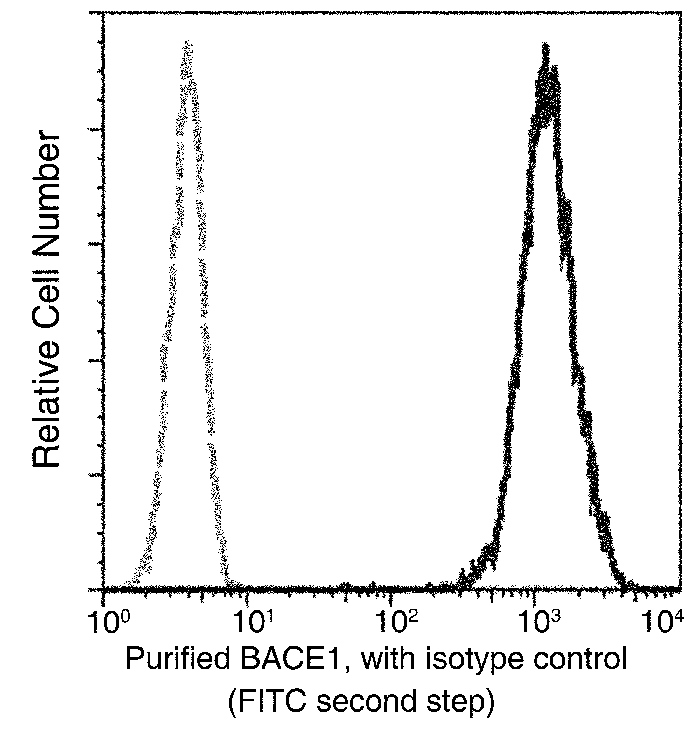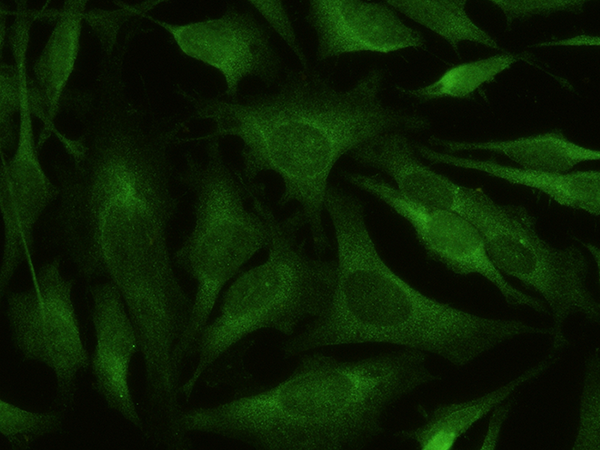-
Product Name
Anti-BACE1 antibody
- Documents
-
Description
Rabbit monoclonal to BACE1
-
Tested applications
FCM, IF, ICC/IF
-
Species reactivity
Human BACE1
-
Alternative names
ASP2 antibody; BACE antibody; HSPC104 antibody; C76936 antibody; ASP2 antibody; BACE antibody; BACE1 antibody; Bace1 antibody; C76936 antibody; FLJ90568 antibody; HSPC104 antibody; KIAA1149 antibody
- Immunogen
-
Isotype
Rabbit IgG
-
Preparation
This antibody was obtained from a rabbit immunized with purified, recombinant Human BACE1 (rh BACE1; NP_036236.1; Met1-Thr457).
-
Clonality
Monoclonal
-
Formulation
0.2 μm filtered solution in PBS with 5% trehalose
-
Storage instructions
This antibody can be stored at 2℃-8℃ for one month without detectable loss of activity. Antibody products are stable for twelve months from date of receipt when stored at -20℃ to -80℃. Preservative-Free.
Sodium azide is recommended to avoid contamination (final concentration 0.05%-0.1%). It is toxic to cells and should be disposed of properly. Avoid repeated freeze-thaw cycles. -
Applications
FCM: 0.5-2 μg/Test
ICC/IF: 10-25 μg/mL
-
Validations

BACE1 Antibody, Rabbit MAb, Flow cytometric analysis
Flow cytometric analysis of Human BACE1 expression on Jurkat cells. The cells were treated according to manufacturer’s manual (BD Pharmingen™ Cat. No. 554714), stained with purified anti-Human BACE1, then a FITC-conjugated second step antibody. The fluorescence histograms were derived from gated events with the forward and side light-scatter characteristics of intact cells.

BACE1 Antibody, Rabbit MAb, Immunofluorescence
Immunofluorescence staining of Human BACE1 in Hela cells. Cells were fixed with 4% PFA, permeabilzed with 1% Triton X-100 in PBS, blocked with 10% serum, and incubated with rabbit anti-Human AK4 monoclonal antibody (15 µg/ml) at 37℃ 1 hour. Then cells were stained with the Alexa Fluor® 488-conjugated Goat Anti-rabbit IgG secondary antibody (green) and counterstained with DAPI (blue). Positive staining was localized to cytoplasm.
-
Background
Beta-site APP-cleaving enzyme 1 (BACE1) is an aspartic-acid protease important in the formation of myelin sheaths in peripheral nerve cells. In the brain, This protein is expressed highly in the substantia nigra, locus coruleus and medulla oblongata. Strong BACE1 expression has also been described in pancreatic tissue. BACE1 has a pivotal role in the pathogenesis of Alzheimer's disease. In Alzheimer's disease patients, BACE1 levels were elevated although mRNA levels were not changed. It has been found that BACE1 gene expression is controlled by a TATA-less promoter. The translational repression as a new mechanism controlling its expression. And the low concentrations of Ca(2+) (microM range) significantly increased the proteolytic activity of BACE1. Furthermore, BACE1 protein is ubiquitinated, and the degradation of BACE1 proteins and amyloid precursor protein processing are regulated by the ubiquitin-proteasome pathway. It has also been identified as the rate limiting enzyme for amyloid-beta-peptide (Abeta) production.
-
References
- Christensen MA, et al. (2004) Transcriptional regulation of BACE1, the beta-amyloid precursor protein beta-secretase, by Sp1. Mol Cell Biol. 24(2):865-74.
- Stockley JH, et al. (2007) The proteins BACE1 and BACE2 and beta-secretase activity in normal and Alzheimer's disease brain. Biochem Soc Trans. 35(Pt 3): 574-6.
- Savonenko AV, et al. (2008) Alteration of BACE1-dependent NRG1/ErbB4 signaling and schizophrenia-like phenotypes in BACE1-null mice. Proc Natl Acad Sci U S A. 105(14): 5585-90.
- Hayley M, et al. (2009) Calcium enhances the proteolytic activity of BACE1: An in vitro biophysical and biochemical characterization of the BACE1-calcium interaction. Biochim Biophys Acta. 1788(9): 1933-8.
Related Products / Services
Please note: All products are "FOR RESEARCH USE ONLY AND ARE NOT INTENDED FOR DIAGNOSTIC OR THERAPEUTIC USE"
